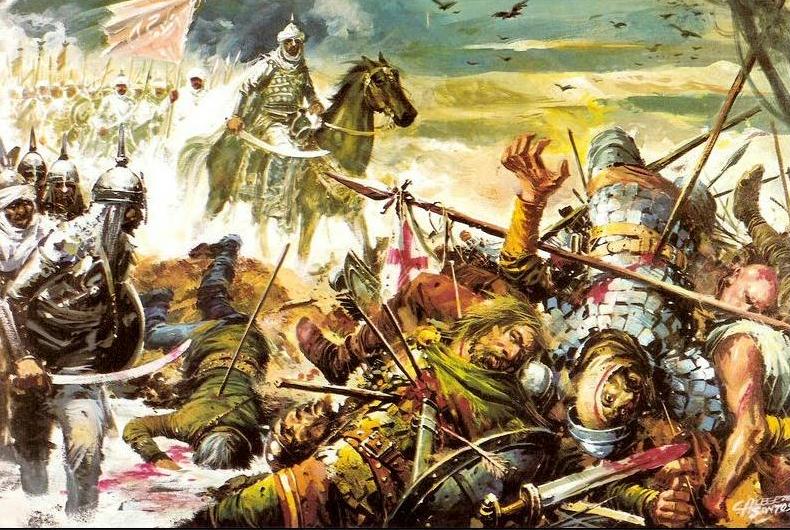
Moorish Invasion of Western Europe (8th Century)

Figure 1.-- The weakness of the Visigothic kingdom was displayed in Roderick's stunning defeat at Guadalete / Río Barbate, (July 19, 711). It is believed that Roderick and much of the Visigothic nobility was killed in the battle and aftermath. Tarik swept north toward Toledo, the Visigothic capital, facing no futher strong resistance. This is a modern view of the Moorish invasion of the decaying Visigothic Kingdom which had dominatred Iberia for 3 centuries. We are not sure yet who the artist is.
|
|
A decade after smashing Byzantine power in North Africa at Carthage (698), the Arabs had not only reached the southern shores of Europe facing Gibraltar, but launched an invasion of Spain. Arab armies had defeated Byzantine armies in the East, but the Byzantines still prevented an Arab invasion of Eastern Europe. That invasion wiukld come in the West. After the conquest of North Africa, the Arabs and their Berber Allies looked across the Strait of Gibraltar at the weak Visigoth kingdom of the Iberian Peninsula. Here a small Germanic ruling class had governed since the fall of the Roman Empire. Musa bin Nusayr, the governor of Muslim North Africa, dispatched his general, Tarik, and his largely Berber army on an expedition across the Strait (711). The defection of Count Julian in Ceuta made this possible. Tarik's army consisted of Muslims of varying origins. Accounts vary. Some sources say the Moorish army was predominately Arabs, but included Berbers, Syrians, and others). Others emphasize Berber origins. The Visigothic King , Roderick, assembeled an army to repulse the Tarik who he thought commanded a small mercinary army. Tarik landed at Gibraltar, the name of which comes from the Arabic Jebel-al Tarik. Roderick proved to be an ineffectual commander. One historian describes him as 'Weighed down by a golden crown, a heavy robe, archaic jewelry, and an ivory carriage drawn by two white mules" [Fuentes, p. 51.] The weakness of the Visigothic kingdom was displayed in Roderick's stunning defeat at Guadalete / Río Barbate, (July 19, 711). It is believed that Roderick and much of the Visigothic nobility was killed in the battle and aftermath. Tarik swept north toward Toledo, the Visigothic capital, facing no futher strong resistance. Visigothic Spain passed into history. The Moors moved through the Visigothic Kingdom (sometimes referred to as the Toulouse Kingdom) destroying any armed resistance. Over the space of only a few years, the Moors almost totally dominated the Peninsula. The only Visagothic victiory occured at Covadonga in the mountaneous northwest (718). Here a surviving Visigothic chieftan named Pelayo stopped a small Morish fiorce. The cost of coquering the rugged moutaneous area proved not worth the effort for the Moors. Ratger their interest turned north to the ruch lands beyond the Pyranees. Muslim armies then ventured across the Pyrenees and established a foothold in southwest France. A furtgher move north was defeated at the Battle of Poitiers by a Frankish army under Charles Martel near Tours (732). While only a relatively minor military scirmish, along with avictory in the East of Byzantine Emperor Leo III ended the phase of rapid advance by Arab armies. The Moors then withdrew south of the Pyrenees. They never again seriously threatened France. Charles Martel would go on to found a powerful state, the foundation of modern France. The Moors were left in control of almost the entire Iberian Pensinsula except for a few small Christian enclaves in the rugged northhwest.
Sources
Fuentes, Carlos. The Buried Mirror: Reflections on Spain and the New World (Houghton Mifflin: New York, 1992), 399p.
CIH

Navigate the Children in History Web Site:
[Return to Main Arab conquest page]
[Return to Main medieval page]
[Return to Main Morrish Spain page]
[Return to The Reconquista]
[Return to Main early war page]
[Return to Main Spanish history page]
[About Us]
[Introduction]
[Biographies]
[Chronology]
[Climatology]
[Clothing]
[Disease and Health]
[Economics]
[Freedom]
[Geography]
[History]
[Human Nature]
[Law]
[Nationalism]
[Presidents]
[Religion]
[Royalty]
[Science]
[Social Class]
[Bibliographies]
[Contributions]
[FAQs]
[Glossaries]
[Images]
[Links]
[Registration]
[Tools]
[Children in History Home]
Created: 1:40 AM 7/15/2013
Last updated: 1:40 AM 7/15/2013



